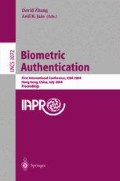Abstract
Conventional algorithms for fingerprint recognition are mainly based on minutiae information. But it is difficult to extract minutiae accurately and robustly for elder people. One of main reasons is that there are too many creases on the fingertips of elder people. In this paper, we will propose a novel algorithm to improve fingerprint recognition based on crease detection. First, creases are extracted by using some special filters. Then the minutiae detected by using conventional algorithms can be further processed and those on or near the creases are discarded as false minutiae. The experimental results show that the performance can be improved by applying crease detection to discard the false minutiae. The false rejection rate can be reduced 6% on average for the fingerprints with creases.
Access this chapter
Tax calculation will be finalised at checkout
Purchases are for personal use only
Preview
Unable to display preview. Download preview PDF.
References
Jain, A., Bolle, R., Pankanti, S. (eds.): BIOMETRICS: Personal Identification in Networked Society. Kluwer, New York (1999)
Zhang, D.: Automated biometrics: Technologies and systems. Kluwer Academic Publisher, USA (2000)
Jain, A., Hong, L.: On-line fingerprint verification. IEEE Trans. on Pattern Analysis and Machine Intelligence 19(4), 302–314 (1997)
Jain, A., Hong, L., Pankanti, S., Bolle, R.: An Identity Authentication System Using Fingerprints. Proceedings of the IEEE 85(9), 1365–1388 (1997)
Wu, C., Zhou, J., Bian, Z., Rong, G.: Robust Crease Detection in Fingerprint Images. In: Proceedings of the IEEE Computer Society Conference on Computer Vision and Pattern Recognition, vol. 2, pp. 505–510 (2003)
Acton, S.T., Mukherjee, D.P., Havlicek, J.P., Bovik, A.C.: Fingerprint Classification Using an AM-FM Model. IEEE Transactions on Image Processing 10(6), 951–954 (2001)
Zhou, J., Gu, J.: A Model-based Method for the Computation of Fingerprints’ Orientation Field. IEEE Trans. On Image Processing 12(3) (2004)
Author information
Authors and Affiliations
Editor information
Editors and Affiliations
Rights and permissions
Copyright information
© 2004 Springer-Verlag Berlin Heidelberg
About this paper
Cite this paper
Zhou, J., Wu, C., Bian, Z., Zhang, D. (2004). Improving Fingerprint Recognition Based on Crease Detection. In: Zhang, D., Jain, A.K. (eds) Biometric Authentication. ICBA 2004. Lecture Notes in Computer Science, vol 3072. Springer, Berlin, Heidelberg. https://doi.org/10.1007/978-3-540-25948-0_40
Download citation
DOI: https://doi.org/10.1007/978-3-540-25948-0_40
Publisher Name: Springer, Berlin, Heidelberg
Print ISBN: 978-3-540-22146-3
Online ISBN: 978-3-540-25948-0
eBook Packages: Springer Book Archive

